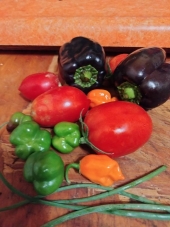
 4
4





 3
3




 3
3




14ac Central California foothills, up for collaboration in Central CA

 5
5




How Permies works: https://permies.com/wiki/34193/permies-works-links-threads
My projects on Skye: The tree field, Growing and landracing, perennial polycultures, "Don't dream it - be it! "
 4
4




Invasive plants are Earth's way of insisting we notice her medicines. Stephen Herrod Buhner
Everyone learns what works by learning what doesn't work. Stephen Herrod Buhner
 3
3




 2
2




Mike Lafay wrote:This sound like a good idea to try. but with the results you got, I would try two things:
First, if you can have those plants in a spot where they just won't get cold, like a greenhouse; maybe setting up one around them, or having a micro-climate that keep enough eat and gives it back at night, like a huge stone,a wall... however in my experience they just won't tolerate frost; or maybe they can tolerate frost, but only if they are thawed reaaally slowly (like with some flower or fruits, like Sepp Holzer does), but it's an hypothesis.
Second, maybe layering, instead of digging up the plant would be better ? Tomatoes stem will root if covered, so maybe it could be used to spread one plant to a container, then you cut it and put the container in a warm enough spot.
Also, maybe there are cold hardy heirloom varieties that could be used, but I don't know of any.
Invasive plants are Earth's way of insisting we notice her medicines. Stephen Herrod Buhner
Everyone learns what works by learning what doesn't work. Stephen Herrod Buhner
 4
4




Weeds are just plants with enough surplus will to live to withstand normal levels of gardening!--Alexandra Petri
 1
1




 5
5




Zone 6, 45 inches precipitation, hard clay soil




 1
1




 4
4




Anne Miller wrote:Eggplants grow wild in their native South Asia.
We have had peppers and tomatoes grow here when we pick the fruit in December. We bring the fruit in to ripen and the plant just keeps growing. I never thought about just cutting the plant back in the spring and let it keep growing.
I have a really hard time dealing with aphids. I had a milkweed that I just could not keep the aphids and ants off so I just quit watering it so it died. And I would not like having them in my house.
As an experiment why not do like L Johnson suggested that "some farmers here cut back and defoliate their eggplant"?
Do this with all three, the peppers, eggplants, and tomatoes. Cut the leaves back and defoliate them and see what happens.
If you decide to do this experiment, please let us know how it turns out.




Mk Neal wrote:I brought in a potted jalapeno this year to try overwintering it. So far its happy enough with no special treatment. Tomatoes I would not bother with in my location, because they have usually picked up some fungal disease by the fall, and I suspect any indoor winter growth would be weak and leggy. Better to start new plants.
 2
2




 3
3








Zone 6, 45 inches precipitation, hard clay soil








May Lotito wrote:I have been taking tomato cuttings to over winter successfully. It saved me money to buy new ones every year and I have extra to share.
I tried for the first time to over winter my bell pepper plants indoor. I dug up the plants about one week before frost to repot. One plant had a smaller root ball and wilted so I trimmed it down to a few branches. It survived and started growing new buds near the base. Another one I used a big pot and the whole thing weighs 40 lbs. This one experienced minimal shock and kept on maturing peppers and produced new ones too.
I did find some aphids and just eliminated them by hand. Just don't overlook those tiny cocoons.
Starting nightshades much earlier indoor is a good idea. Bigger plants will produce earlier. Also warm up the soil around peppers somehow so they won't stall after transplanting.
Photo attached is my 2ft wide pepper plant by a SWS window. That bell pepper is grown entirely indoor. The small one in the back is another pepper rooted from cutting.
 3
3




Zone 6, 45 inches precipitation, hard clay soil




 1
1




Jenny Wright wrote:This tomato sprouted out of some dried up compost that was sitting under cover on my porch all summer (no rain or any kind of water for 4+months)... It sprouted in September (cold weather) and the compost felt as dry as dust so just the humidity in the air I guess was keeping it alive. It was over 12" tall when I took pity on it and put it in a real pot and started watering it. It's keeping the pepper in my previous picture company.
 2
2




Jenny Wright wrote:This is the only pepper that is doing well. It was teeny tiny though so I don't think its root were disturbed when I dug it up. It is actually pretty happy, blossomed and set fruit. There were some sugar ants crawling in it so I think they pollinated it.

|
Everyone is a villain in someone else's story. Especially this devious tiny ad:
The new gardening playing cards kickstarter is now live!
https://www.kickstarter.com/projects/paulwheaton/garden-cards
|






